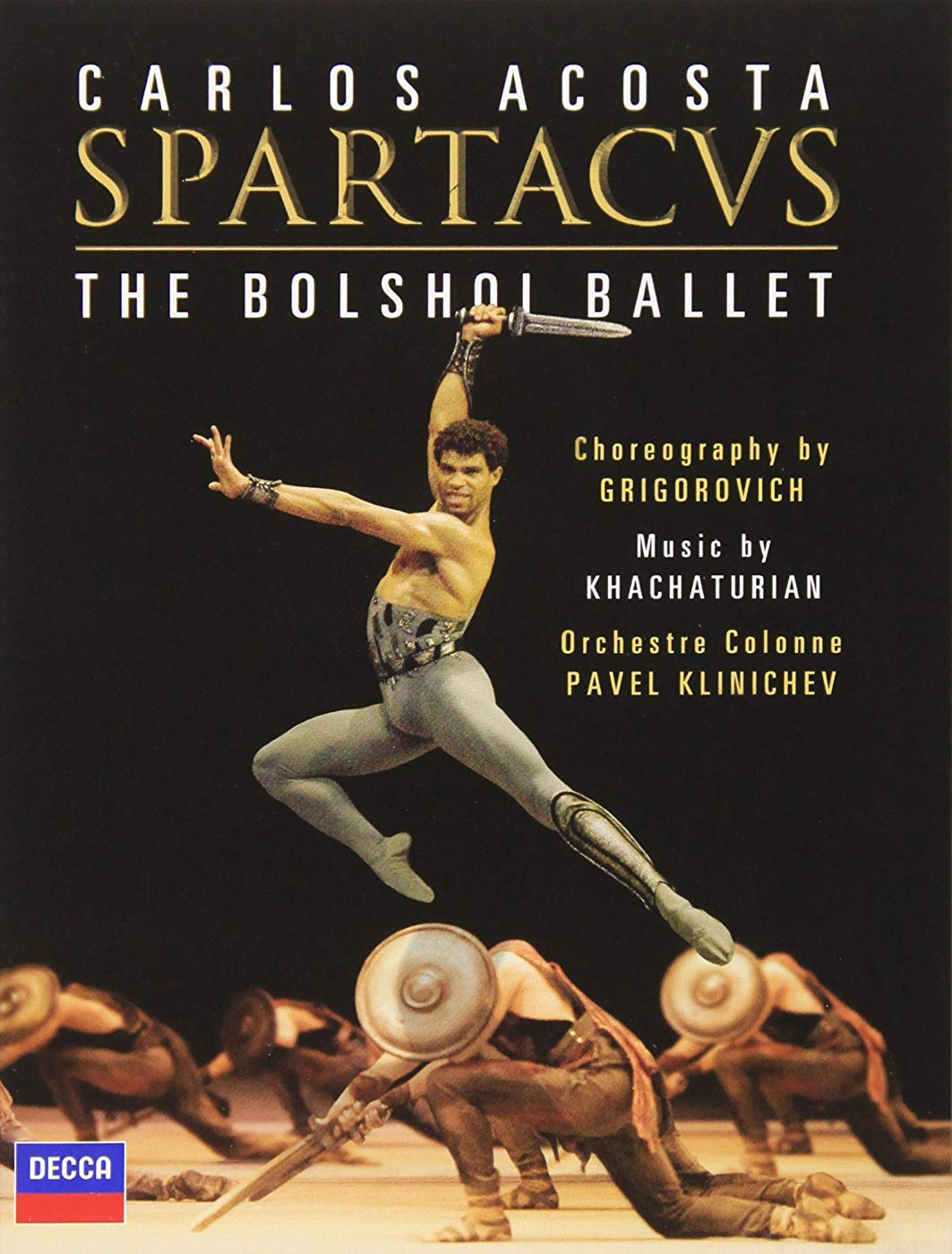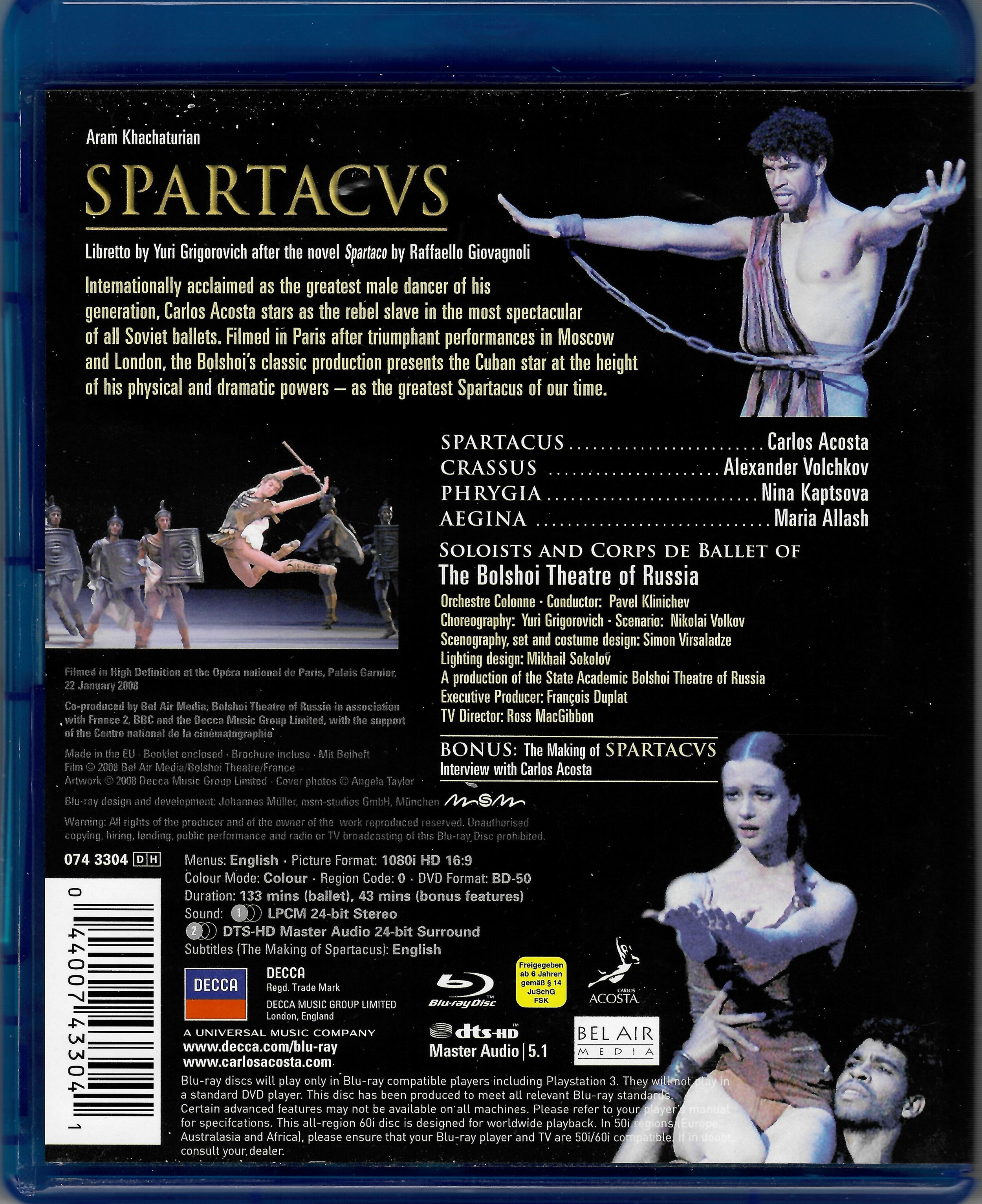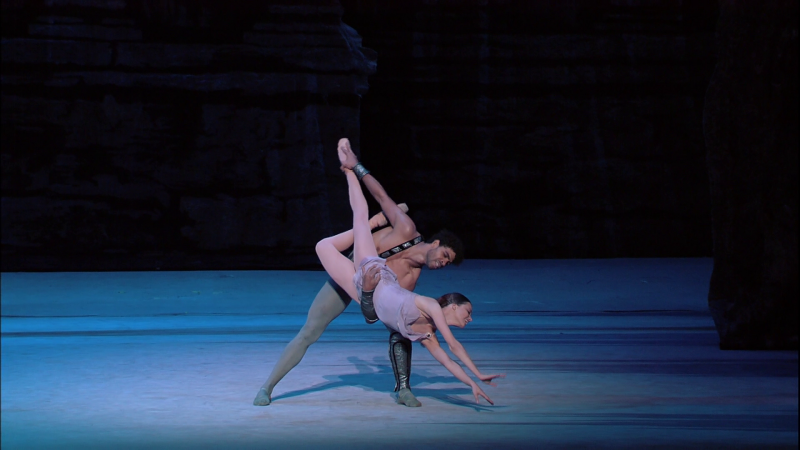

Spartacus ballet. Music by Aram Khachaturian. Libretto and choreography by Yuri Grigorovich. Production of the State Academic Bolshoi Theatre of Russia. Performed 2008 at the Opéra national de Paris, Palais Garnier. Stars Carlos Acosta (Spartacus), Alexander Volchkov (Crassus), Nina Kaptsova (Phrygia), and Maria Allash (Aegina) supported by the Corps de Ballet of the Bolshoi Theatre of Russia. Pavel Klinichev conducts the Orchestre Colonne. Scenario by Nikolai Volkov; scenography, set, and costume design by Simon Virsaladze; lighting by Mikhail Sokolov. Directed for TV by Ross MacGibbon; Director of Photography Martial Barrault; Executive Producer François Duplat. Released 2008, disc has 5.1 dts-HD Master Audio sound. Grade A-
The following three paragraphs were written by Work Gordon Smith as our initial review of this recording. Henry McFadyen, Jr. added screenshots and comments later.
“Spartacus tells the story of the slaves' revolt against their Roman masters. It presents a stark contrast to the ephemeral, gossamer idea many of us may have of ballet. For this is dance with a raw, urgent thrust in which the spirit of revolt boils up and overflows in a fury of defiance. This dynamic thrust is in the music, in the choreography, and most of all in Carlos Acosta, who sets new standards in male dancing in his performance of Spartacus.
Acosta is capable of portraying the most violent emotions. But he also can convey the tenderest of delicate subtlety as he dances with his wife Phrygia (Nina Kaptsova). It's amazing to see the effortless way he carries her, drapes her over his shoulder, whirls her around, and then sets her down so gently, emphasizing her sylph-like gracefulness. Crassus (Alexander Volchkov), the ruthless, vain, and decadent representative of Imperial Rome is, with his affected haughtiness, perhaps slightly too effeminate at times, although this does emphasis his decadence all the more.
This production, with its dramatic lighting and evocative sets, is served well by HDVD. We can really appreciate its benefits when we have a view of the entire stage and the overall choreographic design. In standard DVD, with its lower resolution, all of this would have been lost in an imprecise, middle-distance blur. Altogether, Spartacus provides an outstanding experience—powerful enough to persuade those who profess indifference to ballet and maybe even change their minds.”
Thank you again, Gordon, for giving us the review above so soon after this disc came out. I'll add more thoughts with some screenshots. Here's Crassus, who in history was not involved with Spartacus until after the slave revolt was well under way. The story as told by Grigorovich is vastly simplified. Folks in the audience probably think Crassus was the Emperor. He was not—he was elected a Praetor. After several generals were defeated by the revolting slaves, Crassus undertook to organize another army to put down the uprising:
Grigorovich early puts a ton of dancers on stage showing the leaders, the soldiers, and lots of slaves with their hands up or bowed down before whips:
Carlos Acosta as Spartacus. This production goes back to 1968, when Grigorovich wrote it, per Jennifer Homans in Appollo's Angels (page 387) as "an epic revolutionary allegory. . . that would be the Bolshoi's calling card for decades to come and its most emblematic ballet." Acosta was one of the few non-Russian men to ever be asked by the Bolshoi to dance this. So it was a once-in-a-lifetime opportunity for him:
Phrygia (Nina Kaptsova) is Spartacus' wife: Both Spartacus and Phrygia were free but were captured in a war and are now slaves of Crassus. In this and other screenshots below you will note the heavy use of colored light as a design element. I think this may now date this show as a product of an bygone era:
This is Aegina (Maria Allash), a courtesan who hopes to attain nobility through Crassus:
Crassus and Aegina stage an orgy for the amusement of their friends. Aegina, an expert in such matters, has provided satyrs and nymphs to get the party going. As an orgy victim, Crassus provides his prettiest slave, who happens to be poor Phrygia:
Crassus and Aegina soon join in the fun:
Crassus also stages a gladiator contest with both fighters blindfolded. Spartacus is the winning fighter on the right:
After winning the contest, Spartacus learns he has killed one of his closest friends. He resolves to regain his freedom at all costs and starts to recruit rebels:
Phrygia also survived the orgy, and the couple meets for a spectacular pas de deux. They get applause for this lift with one hand each:
By now, everyone hates the Romans. But Grigorovich also gives Crassus and Aegina a spectacular pas de deux:
The next two shots show Roman women portrayed by the Bolshoi female corps in surprisingly understated and alluring formations of dancing almost in slow-motion. It's a brilliant way to cool things down after all the fast action of the ballet so far:
Spartacus and rebels enter the palace and surprise Crassus. Crassus is defeated. He defiantly offers his neck to Spartacus. But Spartacus is too noble to execute Crassus and lets him go. This will prove to be a big mistake in the short run. But taking the long view, Spartacus will be much more famous 2000 years later than Crassus:
While waiting for the next Roman reaction to the uprising, Spartacus and Phrygia have time for themselves:
But already there are divisions in the ranks of the slaves. Aegina enlists her courtesan interns. They throw a party for a group of the rebels complete with Aegina's stick dance. Once they are drunk, Aegina informs on the rebels to Crassus, who takes advantage of the rebel lack of discipline to mount a counter-attack and capture Spartacus:
Aegina is rewarded for her services to the Roman state:
Spartacus is killed and his body is given to the defeated rebels for burial. In history, of course, the rebellion ended in a slightly different way. After months of skirmishes, there was a big battle in which the rebels were crushed. It's unclear what happened to Spartacus, but some 6000 slaves were captured. They then began a slow march to Rome in which a slave was crucified every 100 meters or so. The few that made it to Rome were then killed at the Coliseum:
So what to make of Spartacus? Jennifer Homans in her Apollo's Angels book says that even though all the classical steps are there, Spartacus isn't classical ballet. She views it as a propaganda blowout that's too rough and masculine to be included in the classical canon. Well, you probably would not want to show this Spartacus to Granny. But as Wonk Gordon Smith points out, if you want to get more men interested in ballet, maybe we need something like Spartacus to offer them along with Giselle and Swan Lake. I also note that Grigorovich is still busy in Moscow trying to make the Bolshoi the best ballet in the world with astonishing new works like his Sleeping Beauty. So I would suggest that Spartacus belongs on the list of great ballets—just be aware of what you're getting into.
I do think that the garish lighting you see above detracts from the production. Also, the videography, while vastly better than any DVD made on such a Bolshoi stage, is a bit soft by today’s standards and was probably hurt significantly by the extreme lighting. For these reasons and on account of the simplistic Gregorovich libretto, I'm moving the grade from A to A-. Maybe Grigorovich will update this in the renovated Bolshoi building.





















